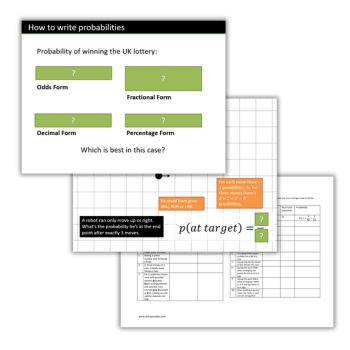Word docs, Excel spreadsheet, PowerPoint and PDF
KS3
Years 7-9
In this KS3 probability lesson plan, aimed at Year 8, students will:
- Determine probabilities using matching outcomes/total outcomes
- Understand the concept of a ‘sample space’
- Identify the sample space for both a single event and two combined events (eg adding two dice) and use to calculate probabilities
- Understand the difference between experimental and theoretical probabilities
- Calculate experimental probabilities/relative frequencies
- Estimate the most likely count given the number of trials and a probability
KS3 probability resources
This download contains:
- KS3 2D sample space homework activity
- Coin probability activity
- Dice probability demo
- KS3 probability PowerPoint
- KS3 probability worksheet pack
- Year 8 quiz
- Probability robot activity
KS3 maths curriculum area
Probability
- Understand that the probabilities of all possible outcomes sum to 1
- Generate theoretical sample spaces for single and combined events with equally likely, mutually exclusive outcomes and use these to calculate theoretical probabilities
Coin probability activity
Give each group a grid with large 5cm x 5cm squares, and a 1p and 2p coin. Play a game where you have to toss a coin onto the grid. You win if the coin doesn’t overlap with any of the lines. Don’t count throws if the centre of the coin is outside the play area.
Task 1
By repeatedly playing the game 30 times, determine a suitable experimental probability of winning with each coin.
Dr Frost is a maths teacher working at Tiffin School in London. You can find all of his resources at his website drfrostmaths.com. Browse a probability dice-rolling lesson plan.














